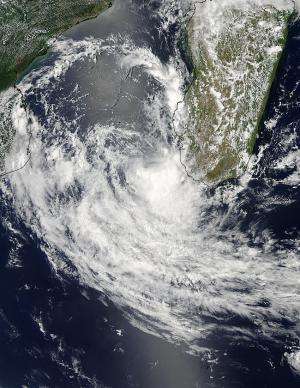NASA satellite catches birth of Tropical Cyclone Deliwe

The tropical depression southwest of Madagascar on January 16 developed into a tropical cyclone early on January 17 as NASA's Aqua satellite passed overhead and captured its birth.
When Aqua passed over newborn Tropical Cyclone Deliwe on January 17 at 10:55 UTC/5:55 a.m. EST the MODIS instrument or Moderate Resolution Imaging Spectroradiometer took a picture of it. Deliwe was previously known as Tropical Depression 09S. In the MODIS image bands of thunderstorms stretched west into the Mozambique Channel and south into the Southern Indian Ocean.
Forecasters at the Joint Typhoon Warning Center using multispectral satellite imagery indicated that Deliwe has a well-defined low-level center of circulation.
On January 17 at 0900 UTC/4 a.m. EST, Deliwe had maximum sustained winds near 45 knots/51.8 mph/ 83.3 kph. It was centered near 23.8 south and 42.0 east, about 375 nautical miles/431.5 miles/694.5 km southwest of Antananarivo, Madagascar. Deliwe is moving to the south-southwest. Deliwe is moving along the western edge of a subtropical ridge of high pressure centered east of Madagascar. As a new subtropical ridge of high pressure builds in west of the tropical cyclone, it is expected to turn and steer Deliwe to the northwest.
Forecasters at the Joint Typhoon Warning Center expect Deliwe to move southwest and then curve northwest. Computer models indicate that vertical wind shear is expected to increase after a day, and the tropical cyclone could dissipate in four days or before that.
Provided by NASA's Goddard Space Flight Center




















